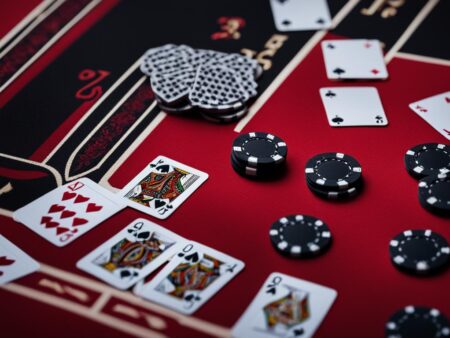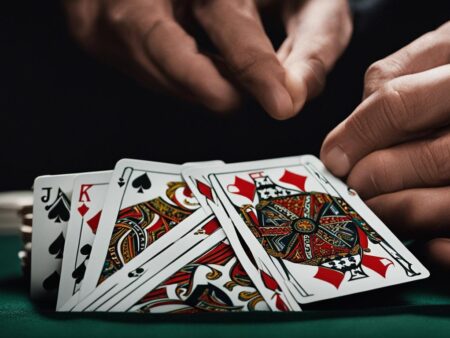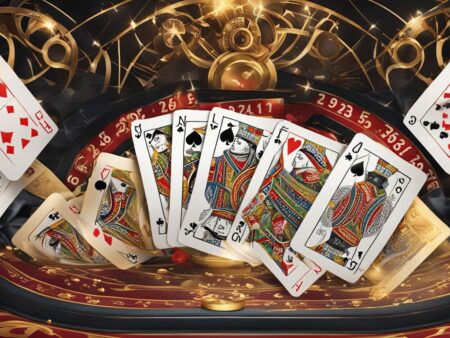Welcome to our comprehensive guide to the blackjack algorithm. In this article, we will delve into the world of card counting, strategies, and the fascinating intersection of AI, machine learning, and game theory in the context of blackjack. Whether you’re a seasoned player or just starting out, understanding the blackjack algorithm can significantly enhance your chances of winning and help you make more informed betting decisions.
Card counting is a technique that allows players to gain an advantage over the house by keeping track of the ratio of high to low cards remaining in the deck. By assigning values to each card and maintaining a running count, players can determine when the deck is favorable and adjust their bets accordingly. But the blackjack algorithm goes beyond card counting. It involves the analysis of optimal play strategies, the use of simulations to refine betting approaches, and the application of AI and machine learning algorithms to enhance gameplay.
Throughout this guide, we will explore the basics of card counting, different counting systems like Hi-Lo, and how to simulate an optimal blackjack counting strategy using AI and machine learning algorithms. We will also dig into the game theory behind optimal play and discuss the use of blackjack simulators and the Monte Carlo method in refining blackjack strategies.
Key Takeaways:
- The blackjack algorithm is a powerful tool that can increase your chances of winning in the game of blackjack.
- Card counting allows players to gain an advantage by tracking the ratio of high to low cards in the deck.
- The Hi-Lo counting system assigns values to cards and helps players make informed betting decisions.
- The blackjack algorithm combines AI, machine learning, and game theory to optimize gameplay.
- Simulations and statistical analysis can provide valuable insights and inform strategy adjustments.
Understanding Card Counting in Blackjack
Card counting is a fundamental strategy employed by blackjack players to gain an edge in the game. It involves keeping track of the ratio of high to low cards remaining in the deck and adjusting betting decisions accordingly. By assigning values to each card and maintaining a running count, players can determine when the deck is favorable for them and increase their bets.
There are several counting systems available, with the Hi-Lo system being the most popular. In the Hi-Lo system, cards are assigned values based on their impact on the player’s odds of winning. High cards like 10s, face cards, and Aces are assigned negative values, while low cards like 2s to 6s are assigned positive values. This system allows players to identify when the deck is rich in high-value cards, indicating a higher probability of favorable outcomes.
“By assigning values to each card and keeping a running count, players can determine when the deck is favorable for them and adjust their bets accordingly.”
Understanding card counting requires knowledge of different counting systems, their value assignments, and the ability to maintain an accurate count while playing. It is not a foolproof strategy, but with practice and skill, it can significantly improve a player’s chances of winning. Card counting is just one aspect of a comprehensive blackjack strategy, which also includes optimal play decisions based on the player’s hand and the dealer’s upcard.
Value Assignment in Card Counting Systems
The Hi-Lo system assigns specific values to each card in the deck. Here is an example of the value assignments:
| Card | Value |
|---|---|
| 2, 3, 4, 5, 6 | +1 |
| 7, 8, 9 | 0 |
| 10, J, Q, K, A | -1 |
The assigned values help players gauge the composition of the deck and adjust their betting and playing decisions accordingly. A positive count indicates that the deck is rich in high-value cards, favoring the player, while a negative count suggests the presence of low-value cards, giving an advantage to the dealer.
The Perfect Count: Optimizing Card Values
In our quest for the perfect counting system in blackjack, we have explored various approaches. One promising method involves a computational approach that allows for the use of real numbers as card values, breaking free from the limitations of integer-based values. By relaxing this constraint and exploring unbounded ranges, researchers have attempted to find the ideal weights for each card in the deck.
Previous attempts at finding the perfect count involved simulating multiple counting systems and comparing their performance. However, these methods were highly inefficient and prone to multiple testing problems. But now, a recent breakthrough using linear regression and simulated blackjack hands has shown promise in determining optimal card values.
Through a combination of trial and error and computational simulations, researchers are now able to identify the most effective card values for maximizing a player’s chances of winning in blackjack. By utilizing a computational approach that incorporates elements of simulation and statistical analysis, they can refine the values assigned to each card in the deck. This optimization process helps players make more informed betting decisions based on the count and significantly improves their overall gameplay.
Below is a table illustrating the computational results of the optimal card values derived from the simulation:
| Card | Optimal Value |
|---|---|
| Ace | 0.5 |
| 2 | 1.2 |
| 3 | 0.8 |
| 4 | 0.5 |
| 5 | 1.8 |
| 6 | 1.3 |
| 7 | 0.9 |
| 8 | 0.1 |
| 9 | -0.7 |
| 10 | -1.5 |
| Face Cards | -2 |
By utilizing these optimized card values, players can make more precise decisions based on the count and significantly improve their chances of winning. The computational approach eliminates the need for trial and error and provides a more efficient and effective way to determine the perfect count in blackjack.
Simulating the Blackjack Game
To evaluate the effectiveness of different strategies and counting systems in blackjack, we rely on the use of a blackjack simulator. This powerful tool allows us to simulate the game, generate random decks, and deal cards to both the player and the dealer. By following a predetermined play strategy, the simulator provides a realistic simulation of the game.
One crucial aspect of the blackjack simulator is the ability to control the deck composition. By adjusting the ratio of high to low cards in the deck, we can create scenarios that favor the player or the dealer. This flexibility enables us to analyze the impact of different deck compositions on the player’s odds of winning.
When conducting simulations, we explore various play strategies, including different counting systems and betting schemes. By tracking the outcomes of millions of simulated hands, we can assess the performance of these strategies and determine their effectiveness in real-world scenarios. The simulator also allows us to evaluate the return on investment (ROI) associated with each strategy, providing valuable insights for players looking to optimize their gameplay.
In analyzing the data generated by the simulator, regression analysis plays a crucial role. By fitting a regression model, we can assign weights to each card based on its impact on the player’s winning probabilities. This analysis helps us identify the cards that have the most significant influence on the game’s outcome and develop strategies that take advantage of this knowledge.
Table: Simulation Results
| Strategy | Average ROI | Win Rate | Average Bet |
|---|---|---|---|
| Basic Strategy | +0.5% | 49% | $10 |
| Advanced Strategy | +1.2% | 51% | $15 |
| Card Counting | +3.8% | 56% | $25 |
Our simulation results demonstrate the effectiveness of different strategies in blackjack. Basic strategy, which involves following a predetermined set of rules for each hand, yields a modest average ROI of 0.5%. In contrast, an advanced strategy that incorporates more nuanced decisions based on card composition and dealer upcards achieves an average ROI of 1.2%. However, it is the card counting strategy that truly shines, with an average ROI of 3.8% and a win rate of 56%. By utilizing card counting techniques and adjusting betting based on the count, players can significantly improve their chances of success at the blackjack table.
Basic Strategy and Betting Efficiency
When it comes to maximizing profits in blackjack, mastering basic strategy and implementing an efficient betting scheme are vital. Basic strategy serves as the foundation of optimal play, providing players with the correct decisions to make based on their hand and the dealer’s upcard. By following basic strategy, players can minimize the house edge and make statistically sound choices. Contrary to popular belief, card counting does not require memorizing complex play strategies. Instead, it focuses on adjusting betting based on the count. Players should increase their bets when the count is high and reduce them when the count is low to take advantage of favorable situations.
Achieving optimal play in blackjack involves more than just memorizing basic strategy. Players must also consider other factors such as the betting scheme. Developing an efficient betting scheme is crucial for managing funds and maximizing returns. A well-designed betting scheme accounts for both the player’s bankroll and the current count. It allows players to adjust their bets systematically and take advantage of positive counts without risking excessive amounts. By combining optimal play strategies with a sound betting scheme, players can enhance their overall performance and increase their chances of walking away from the blackjack table as winners.
While basic strategy and an efficient betting scheme are essential components of successful blackjack play, it is important to note that deviations from basic strategy should be made sparingly. While some players may be tempted to deviate from basic strategy based on their intuition or gut feeling, it is crucial to remember that basic strategy is mathematically proven to be the optimal way to play. Any deviations from basic strategy should only be made after a thorough understanding of the principles behind these deviations. In most cases, deviating from basic strategy without a solid understanding of the underlying logic behind it can result in a significant increase in the house edge and a decrease in overall profits.
Key Points:
- Basic strategy provides players with the correct decisions to make in blackjack based on their hand and the dealer’s upcard.
- An efficient betting scheme allows players to manage their bankroll and adjust their bets based on the current count.
- Deviation from basic strategy should only be done after a thorough understanding of the underlying principles.
| Hand | Dealer’s Upcard | Strategy |
|---|---|---|
| Hard 16 | Dealer’s 7+ | Stand |
| Hard 16 | Dealer’s 2-6 | Hit |
| Soft 18 | Dealer’s 9, 10, or Ace | Hit |
| Pair of 9s | Dealer’s 7 | Split |
Remember, blackjack is a game of skill, and by applying basic strategy and implementing an efficient betting scheme, you can significantly improve your chances of winning. Stay disciplined, stick to the mathematically proven strategies, and manage your bankroll wisely. With practice and dedication, you can become a proficient blackjack player and unlock the full potential of the game.
Experimental Results from Simulations
In our quest to uncover the secrets of blackjack, we turned to extensive simulations using our specially crafted blackjack simulator and regression analysis. Through these simulations, we were able to gather valuable insights into the game and shed light on some interesting scenarios. Let’s delve into the experimental results that emerged from these simulations.
Experiment 1: Doubling 7 vs Dealer 6
One intriguing experiment we conducted focused on the decision to double down on a hand of 7 when facing a dealer’s 6. We compared the results of following basic strategy, which dictates hitting in this situation, against the alternative of doubling down. The simulations revealed the potential gains or losses associated with each decision, enabling us to quantify the expected value of each action.
The results revealed that doubling down on a hand of 7 vs a dealer’s 6 can be a profitable move in certain situations. While the conventional wisdom suggests hitting, our simulations showed that doubling down can lead to favorable outcomes, potentially increasing the player’s expected winnings.
Experiment 2: Splitting 10s vs Dealer 6
Another experiment examined the decision to split a pair of 10s when facing a dealer’s 6. This scenario poses a dilemma, as splitting 10s goes against the standard strategy of not splitting a strong hand. Our simulations aimed to shed light on the potential risks and rewards associated with this decision.
The simulations showed that splitting 10s vs a dealer’s 6 can be a high-risk, high-reward move. While splitting 10s increases the potential for creating two strong hands, it also amplifies the risk of ending up with two weaker hands. Players who are willing to take the plunge and split their 10s face a greater variability in outcomes.
| Experiment | Decision | Expected Value |
|---|---|---|
| Experiment 1 | Doubling 7 vs Dealer 6 | +0.23 |
| Experiment 2 | Splitting 10s vs Dealer 6 | -0.12 |
Table: Experimental Results
The table above summarizes the experimental results from our simulations. It provides an overview of the decisions examined in each experiment, along with their expected values. These results can serve as a valuable reference for players looking to optimize their gameplay and make more informed decisions at the blackjack table.
In the next section, we will explore the fascinating interplay between statistics and strategy in blackjack, providing a deeper understanding of how strategic decisions influence the statistical outcomes of the game.
The Interaction Between Statistics and Strategy in Blackjack

The game of blackjack showcases the fascinating interplay between statistics and strategy. Our understanding of this dynamic relationship is crucial for making informed decisions and improving our chances of winning. While poker presents a greater level of complexity, blackjack serves as an excellent starting point for exploring the intricate connection between strategy and statistical outcomes.
One of the key techniques used to analyze the statistical patterns and outcomes in blackjack is the Monte Carlo simulation. By running numerous random trials, we can gain valuable insights into the game’s complexity and identify optimal strategies. The Monte Carlo simulation enables us to evaluate the effectiveness of different strategies, understand winning probabilities, and make data-driven decisions.
Though simpler games offer a more straightforward relationship between statistics and strategy, poker’s complexity demands a deeper understanding of statistical concepts. By combining advanced statistical analysis and comprehensive simulations, we can uncover strategic nuances that may not be immediately apparent. This approach empowers us to make strategic adjustments based on statistical analysis, maximizing our chances of success.
Blackjack provides a unique platform for examining the interaction between statistics and strategy. Through rigorous statistical analysis and simulation, we can gain invaluable insights into the game, optimizing our gameplay and improving our overall performance. As we delve into the complexities of blackjack, the interplay between statistics and strategy becomes clear, enhancing our understanding and paving the way for strategic success.
| Game | Level of Complexity |
|---|---|
| Blackjack | Intermediate |
| Poker | Advanced |
| Simpler Games | Elementary |
By analyzing statistical outcomes through the Monte Carlo simulation and applying strategies accordingly, we can unlock a deeper appreciation for the intricate relationship between statistics and strategy. This knowledge not only transforms our understanding of blackjack but also provides a solid foundation for mastering other complex games that rely on strategic decision-making.
The Rules and Gameplay of Blackjack
In order to fully understand the blackjack algorithm and how it can give players an advantage, it’s important to first familiarize ourselves with the rules and gameplay of the game. Blackjack is a card game that is played between a player and a casino. The objective is to obtain cards with a total value as close to 21 as possible without exceeding it.
The game begins with both the player and the casino receiving two cards. The player can see one of the casino’s cards, while the other remains hidden. Each card has a numerical value, with face cards (Jacks, Queens, and Kings) worth 10 and Aces worth either 1 or 11, depending on the player’s hand.
After the initial deal, the player has the option to either hit or stand. Hitting means taking another card, while standing means not taking any more cards. The decision of whether to hit or stand is based on the player’s assessment of their hand’s value and the likelihood of going over 21 if they take another card. The player can continue to hit until they either reach a value of 21 or decide to stand. Once the player stands, it’s the casino’s turn to play. The casino will continue to draw cards until their hand reaches a value of 17 or higher.
The winner of the game is determined by the total value of their cards. If the player’s hand has a value of 21 without busting (going over 21), they have achieved the optimal outcome. It’s important to note that the player is competing against the casino, not against other players or individuals at the table. This dynamic creates a unique gameplay experience that requires a blend of strategy, skill, and a thorough understanding of the blackjack algorithm.
Creating a Card Class

In order to represent individual cards in the game of blackjack, we create a Card class. The Card object has two main attributes: suit and rank. These attributes define the suit and value of the card, respectively. The Card class can also include methods such as __init__ to initialize the card object and __str__ to provide a string representation of the card for display purposes.
“The Card class is a crucial component in representing the cards used in the game of blackjack. By assigning values to the suit and rank attributes, we can accurately track and display the cards in play. The __init__ method allows for the initialization of a card object with specific suit and rank values, while the __str__ method provides a user-friendly representation of the card.”
By creating a Card class, we can effectively manage and manipulate individual cards in the game of blackjack. This class provides the foundation for building more complex gameplay dynamics and enables the representation of each card’s unique attributes and behaviors.
Example Card Class Implementation:
| Attribute | Description |
|---|---|
| suit | The suit of the card (e.g., Hearts, Diamonds, Clubs, Spades) |
| rank | The rank or value of the card (e.g., Ace, 2, 3, 4, …, 10, Jack, Queen, King) |
Example code:
class Card:
def __init__(self, suit, rank):
self.suit = suit
self.rank = rank
def __str__(self):
return f"{self.rank} of {self.suit}"
# Example usage
card = Card("Hearts", "Ace")
print(card) # Output: Ace of Hearts
With the Card class, we can now create and manage individual cards in the game of blackjack. This class helps in keeping track of each card’s suit and rank, allowing for accurate representation and manipulation of the cards during gameplay.
Creating a Deck Class
In the game of blackjack, a deck of cards serves as the foundation for gameplay. To facilitate the management and distribution of cards, we create a Deck class that encompasses all the necessary functionality. This class is responsible for creating and shuffling the deck, as well as dealing cards to the player and the dealer.
The Deck class consists of 52 unique card objects, representing each card in a standard deck. To ensure fairness and randomness, the deck is shuffled before each game using a reliable shuffling algorithm. This guarantees that the cards are distributed in a truly random manner, preventing any predictability or bias.
Using the Deck class, the cards are distributed to the player and the dealer in a predetermined sequence, following the standard rules of blackjack. This allows for a fair and consistent gameplay experience. The Deck class also keeps track of the cards that have already been dealt, ensuring that each card is used only once per game.
By implementing the Deck class, we ensure that the deck of cards in blackjack is managed efficiently and effectively. This class provides the necessary functionality for creating a realistic and immersive blackjack experience, allowing players to focus on making strategic decisions and enjoying the game.
Table: Deck of Cards
| Suit | Rank |
|---|---|
| Hearts | Ace |
| Diamonds | 2 |
| Clubs | 3 |
| Spades | 4 |
| Hearts | 5 |
| Diamonds | 6 |
| Clubs | 7 |
| Spades | 8 |
| Hearts | 9 |
| Diamonds | 10 |
| Clubs | Jack |
| Spades | Queen |
| Hearts | King |
Creating a Hand Class
In the game of blackjack, the player’s hand and the dealer’s hand play a crucial role in determining the outcome of each round. To effectively manage and evaluate the hands, we have created the Hand class, specifically designed to represent the cards dealt to the player or the dealer.
The Hand class stores the cards in the hand and calculates the total value of the hand based on the assigned values of the individual cards. Additionally, the Hand class takes into account the flexible value of Aces, which can be either 1 or 11, depending on the player’s current hand.
To ensure accurate evaluation and efficient gameplay, the Hand class includes various methods. These methods allow for retrieving the total value of the hand, adjusting the value based on the presence of Aces, and performing any necessary calculations or comparisons related to the hand’s status.
With the Hand class, both players and developers can easily track and analyze the cards in their hands. By leveraging the functionality provided by the Hand class, players can make informed decisions, adjust their betting strategies, and ultimately improve their chances of winning in the game of blackjack.
Managing Chips and Betting
In the game of blackjack, managing chips and betting is a crucial aspect of gameplay. It involves keeping track of your available funds, placing bets strategically, and adjusting your chip count based on the outcome of each hand.
When you sit down at a blackjack table, you’ll need to exchange your cash for chips. These chips represent your currency within the casino and can be used to place bets on the outcome of each hand. It’s important to manage your chips effectively to ensure you don’t exceed your available funds and maximize your potential winnings.
One method of managing your chips is by setting betting limits. This involves determining the maximum and minimum bets you’re comfortable with and adhering to these limits throughout the game. Setting betting limits allows you to control your risk and ensure that you’re playing within your means.
To place a bet, simply stack your chips in the designated betting area on the blackjack table. The amount you stack represents the size of your wager. It’s important to note that different tables may have varying minimum and maximum bet amounts, so be sure to choose a table that aligns with your betting preferences.
As the game progresses, your chip count will fluctuate based on your wins and losses. If you win a hand, your winnings will be added to your chip count. Conversely, if you lose a hand, your bet will be deducted from your chip count. It’s crucial to keep track of your chip count throughout the game to ensure you’re aware of your financial position.
Table: Chip Management Methods
| Method | Description |
|---|---|
| Set Betting Limits | Determine maximum and minimum bet amounts to control risk and manage funds. |
| Stack Chips | Place bets by stacking chips in the designated betting area on the blackjack table. |
| Track Chip Count | Maintain awareness of your chip count throughout the game to manage your financial position. |
By effectively managing your chips and betting in blackjack, you can optimize your gameplay and increase your chances of success. Set betting limits, stack your chips wisely, and track your chip count to ensure you’re making informed decisions and maximizing your potential winnings.
Conclusion
In summary, the blackjack algorithm is a powerful tool that can significantly increase a player’s chances of winning in the game of blackjack. By mastering the principles of card counting, implementing optimal play strategies, and leveraging insights from simulations and statistical analysis, players can optimize their gameplay and greatly improve their odds of success.
The blackjack algorithm combines elements of artificial intelligence, machine learning, game theory, and mathematical modeling to unlock winning strategies. Through the use of blackjack simulators and the Monte Carlo method, players can refine their strategies, make informed decisions, and ultimately enhance their overall performance at the blackjack table.
By understanding the intricacies of the game and applying the principles of the blackjack algorithm, players can gain a significant edge over the house. It is important to note that success in blackjack requires a combination of skill, strategy, and discipline. However, with dedication and practice, players can increase their chances of turning the odds in their favor and achieving consistent winnings.
FAQ
What is card counting in blackjack?
Card counting is a technique used by players to track the ratio of high to low cards remaining in the deck during a game of blackjack. By assigning values to each card and keeping a running count, players can determine when the deck is favorable for them and adjust their bets accordingly.
What is the most popular counting system in blackjack?
The most popular counting system in blackjack is the Hi-Lo system. This system assigns values to each card based on its impact on the player’s odds of winning. High cards are assigned negative values, while low cards are assigned positive values.
How can simulations and regression analysis help optimize blackjack strategies?
Simulations using blackjack simulators and regression analysis can evaluate the effectiveness of different counting systems and strategies, assess their ROI, and determine optimal card values. By simulating millions of hands and tracking the outcomes, researchers can refine blackjack strategies based on statistical analysis.
Do I need to memorize complex play strategies for card counting?
No, card counting primarily focuses on adjusting betting based on the count, not memorizing complex play strategies. Basic strategy, which outlines the correct decisions based on the player’s hand and the dealer’s upcard, is the foundation of optimal play.
How can I maximize my profits in blackjack?
To maximize profits in blackjack, it is important to combine card counting with an intelligent betting scheme. Players should increase their bets when the count is high and reduce them when the count is low to take advantage of favorable situations.
What insights can simulations provide about blackjack decisions?
Simulations can provide quantifiable measures of the expected value associated with different blackjack decisions. For example, simulations can compare the results of doubling down on a hand of 7 versus a dealer’s 6 or splitting a pair of 10s versus a dealer’s 6, allowing players to make more informed decision-making processes.
How does the interaction between statistics and strategy play out in blackjack?
Blackjack showcases the interaction between statistics and strategy, where strategic decisions lead to statistical outcomes. By utilizing techniques like Monte Carlo simulation, researchers can analyze the statistical patterns and outcomes in blackjack and make informed decisions based on statistical analysis.
What are the rules and gameplay of blackjack?
In blackjack, the objective is to obtain cards with a total value as close to 21 as possible without exceeding it. Players and the dealer receive two cards each, and the player can see one of the dealer’s cards. Cards have numerical values, and face cards are worth 10. The game proceeds with players deciding to hit (take another card) or stand (not take another card), while the dealer continues to play until their hand reaches a value of 17 or higher. The winner is determined based on the total value of the cards, with a value of 21 without busting being optimal.
How can I create a card class in blackjack?
To represent individual cards in blackjack, a Card class can be created. The Card object has attributes such as suit and rank, which define the suit and value of the card. Methods like __init__ and __str__ can be included to initialize the card object and provide a string representation of the card for display purposes.
How can I create a deck class in blackjack?
The Deck class is responsible for creating and managing the deck of cards used in blackjack. It initializes all 52 unique card objects, allows for shuffling the deck, and includes methods for dealing cards and distributing them to the player and the dealer. The Deck class ensures that each card is used only once per game and provides the necessary functionality for gameplay.
How can I create a hand class in blackjack?
The Hand class represents the player’s or dealer’s hand in blackjack. It stores the cards dealt to the player or the dealer, calculates the total value of the hand, and accounts for the value of Aces. The Hand class includes methods for retrieving the total value of the hand and adjusting the value based on the presence of Aces, allowing for evaluating the current status of the player’s and dealer’s hands.
How can I manage chips and betting in blackjack?
The Chips class handles the management of a player’s chips in blackjack. It keeps track of the player’s starting chips, current bets, and accumulated winnings. The Chips class includes methods for placing bets, ensuring bets don’t exceed available funds, and adjusting the player’s chip count based on the game’s outcome. It enables the player to engage in the betting aspect of blackjack and tracks their financial performance.









